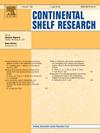Specific oceanographic conditions reflect meiofaunal communities: the case of a semi-enclosed gulf (Pagasitikos Gulf, Eastern Mediterranean)
IF 2.2
3区 地球科学
Q2 OCEANOGRAPHY
引用次数: 0
Abstract
Semi-enclosed gulfs exhibit distinct oceanographic conditions, influencing the inhabiting organisms and communities. Analyzing samples from 55 stations taken at 10 cm sediment depth in spring 2023 and belonging to three zones with different nutrient profiles, the meiofaunal communities in Pagasitikos gulf were examined, while their relationship with sediment properties, water chemistry and oceanographic conditions were investigated. Highest meiofaunal densities were observed in the internal gulf (458–1538 ind/10 cm2) near the main urban area, with lowest reported for the upper external gulf (36–594 ind/10 cm2). Two stations showed unusually high ciliate densities (454 and 598 ind/10 cm2) that could not be explained by any of the examined parameters. Highest richness but lowest evenness, Shannon and Simpson indices were reported for the internal gulf, followed by the lower external gulf, while the upper external zone showed lowest values. Multivariate analyses showed that all three nutrient zones are associated with distinct meiofaunal communities, with depth and sand content being the most important factors influencing the meiofaunal communities, while also discussing the potential effect of anthropogenic activities. Total organic carbon did not explain differences in meiofaunal composition, stressing the need for more precise measurements. This study showcases that gulf-specific oceanographic conditions such as water and nutrient stratification and hydrodynamics can play a key role in shaping meiofaunal communities.
特定的海洋学条件反映了小型动物群落:一个半封闭海湾(东地中海Pagasitikos湾)的情况
半封闭海湾表现出独特的海洋学条件,影响着栖息的生物和群落。分析了2023年春季在10 cm沉积物深度55个站点采集的3个不同营养剖面的样品,对Pagasitikos海湾的小型动物群落进行了研究,并探讨了它们与沉积物性质、水化学和海洋学条件的关系。在主城区附近的内湾(458-1538 ind/10 cm2)观察到最高的小动物密度,而在上部外湾(36-594 ind/10 cm2)报告最低。两个站点显示异常高的纤毛虫密度(454和598 ind/10 cm2),这无法用任何检查的参数来解释。丰富度最高,均匀度最低的是内湾的Shannon和Simpson指数,其次是外湾的Shannon和Simpson指数,而上外湾的Simpson指数最低。多变量分析表明,三个营养带都与不同的小动物群落有关,深度和含沙量是影响小动物群落的最重要因素,同时也讨论了人为活动的潜在影响。总有机碳不能解释微生物组成的差异,强调需要更精确的测量。这项研究表明,海湾特定的海洋学条件,如水和营养分层和水动力学,可以在形成小型动物群落中发挥关键作用。
本文章由计算机程序翻译,如有差异,请以英文原文为准。
求助全文
约1分钟内获得全文
求助全文
来源期刊

Continental Shelf Research
地学-海洋学
CiteScore
4.30
自引率
4.30%
发文量
136
审稿时长
6.1 months
期刊介绍:
Continental Shelf Research publishes articles dealing with the biological, chemical, geological and physical oceanography of the shallow marine environment, from coastal and estuarine waters out to the shelf break. The continental shelf is a critical environment within the land-ocean continuum, and many processes, functions and problems in the continental shelf are driven by terrestrial inputs transported through the rivers and estuaries to the coastal and continental shelf areas. Manuscripts that deal with these topics must make a clear link to the continental shelf. Examples of research areas include:
Physical sedimentology and geomorphology
Geochemistry of the coastal ocean (inorganic and organic)
Marine environment and anthropogenic effects
Interaction of physical dynamics with natural and manmade shoreline features
Benthic, phytoplankton and zooplankton ecology
Coastal water and sediment quality, and ecosystem health
Benthic-pelagic coupling (physical and biogeochemical)
Interactions between physical dynamics (waves, currents, mixing, etc.) and biogeochemical cycles
Estuarine, coastal and shelf sea modelling and process studies.
 求助内容:
求助内容: 应助结果提醒方式:
应助结果提醒方式:


